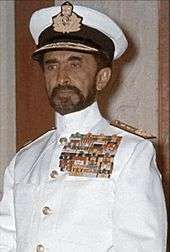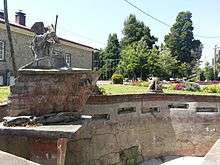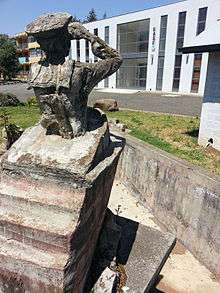Ethiopian Navy
| Ethiopian Navy | |
|---|---|
| Active | 1955-1996 |
| Country |
|
| Branch | Navy |
| Size |
3,500 personnel (in 1991) 26 ships |
| Part of |
Ministry of Defence Ethiopian Armed Forces |
| Headquarters |
Massawa in Eritrea (1955-1990) Addis Ababa (1990-1996) |
| Engagements |
Ethiopian Civil War Eritrean War of Independence |
| Commanders | |
| Commander in Chief (1955-1974) | Emperor Haile Selassie I |
| Deputy Commander (1958-1974) | Rear Admiral Iskinder Desta |
| Insignia | |
| Naval Ensign (1955-1974) |
.svg.png) |
| Naval Ensign (1974–1975) |
.svg.png) |
| Naval Ensign (1975-1996) |
.svg.png) |
| Aircraft flown | |
| Helicopter |
UH-1 Iroquois Mil Mi-8 or Mil Mi-14 |
The Ethiopian Navy, known as the Imperial Ethiopian Navy until 1974, was a branch of the Ethiopian National Defense Force founded in 1955. It was disestablished in 1996 after the independence of Eritrea in 1991 left Ethiopia landlocked.
The Imperial Ethiopian Navy
Founding of the navy
Ethiopia acquired a coastline and ports on the Red Sea in 1950 when the United Nations decided to federate Eritrea with Ethiopia. In 1955, the Imperial Ethiopian Navy was founded, with its primary base—the Haile Selassie I Naval Base -- at Massawa. By the early 1960s workshops and other facilities were under construction at Massawa to give it complete naval base capabilities.
Organization
In 1958, the navy became a fully independent service, organized as one of the three Ethiopian armed services – alongside the Ethiopian Army and Ethiopian Air Force – under the overall command of the Chief of Staff of the Imperial Armed Forces. The navy's deputy commander had his naval headquarters in Addis Ababa. The navy was conceived and built as a coastal navy for patrolling the Red Sea coast.
Training and education
The Imperial Ethiopian Navy's personnel were among the best trained in the world.[1] Even before Ethiopia took control of Eritrea, the British Royal Navy had seconded Ethiopian personnel to its bases in Eritrea to provide them with naval training. A naval college, where Ethiopian naval officers undertook a 52-month program of study, was founded at Asmara in 1956; each class admitted averaged 30 to 40 students in size, and they graduated with a naval commission and a bachelor of science degree.[1] In 1957, a Naval Non-Commissioned Officer School was established at Massawa as well. A Frogman/Diving School for the training of a special commando unit and a Ratings' Training Establishment for the training of naval enlisted men also were established at Massawa by the late 1950s or early 1960s. Centers to provide enlisted men with training in technical specialities were established at Aseb, Asmara, and Massawa. [1]
Emperor Haile Selassie I appointed Royal Norwegian Navy officers to help in organizing Ethiopia's new navy, and they oversaw much of the training. Retired British Royal Navy officers also served as trainers and advisers during Haile Selassie's reign. Some Imperial Ethiopian Navy officers received naval education at the Italian Naval Academy in Livorno, Italy, while others attended the United States Naval Academy in Annapolis, Maryland.[1]
Forces
_2.jpg)
Personnel
At its peak, the Imperial Ethiopian Navy had a force of 3,500 personnel. All enlisted men served seven-year enlistments as volunteers.[1]
Ships
The navy operated a mix of patrol boats and torpedo boats transferred from the United States Navy and the navies of European countries.
The Imperial Ethiopian Navy's first ship was a former U.S. Navy PC-1604-class submarine chaser, ex-USS PC-1616, transferred to Ethiopia on 2 January 1957 via a loan scheme involving Italy and transferred to Italy on 3 May 1959.[1]
In 1962 the United States transferred the former seaplane tender USS Orca (AVP-49) to Ethiopia; renamed Ethiopia (A-01) and placed in service as a training ship, she was the Ethiopian Navy's largest ship throughout her 31 years of service.
Naval aviation
The Imperial Ethiopian Navy established a small naval aviation force of six UH-1 Iroquois helicopters, which operated from the naval air station at Asmara.

Bases
The Imperial Ethiopian Navy established four bases: Massawa was the site of the naval headquarters and enlisted training facilities; the naval air station and naval academy were at Asmara; Assab was the site of a naval station, enlisted training facilities, and a repair dock; and there was a naval station and communications station on the Dahlak Islands in the Red Sea near Massawa.[1]
The Ethiopian Navy in the communist era

Haile Selassie was deposed in 1974, and during the Communist-run governments of the Provisional Military Administrative Council or Derg of 1974 to 1977 and of Mengistu Haile Mariam that followed from 1977 to 1991, the Ethiopian Navy – no longer "Imperial" – was reoriented toward the Soviet Union. Officers continued to train in Ethiopia, but selected naval officers continued their studies at the Soviet naval academy in Leningrad and at Baku. After the Soviet Union was expelled from Somalia for supporting Ethiopia against Somalia in the Ogaden War in 1978, it established naval bases at Assab and on the Dahlak Islands and began to base Soviet Naval Aviation aircraft at Asmara International Airport; in addition, Soviet naval personnel took posts as instructors at the Ethiopian naval academy.[1] Enlisted men continued to train at Massawa and served a seven-year enlistment.
The turn to the Soviet Union meant that the navy became a largely Soviet-equipped force. Although Ethiopia continued in her role as a training ship and remained Ethiopia's largest naval vessel, the United States ceased arms sales to Ethiopia in 1977, and Soviet-built patrol boats and missile boats began to replace other ships. By 1991, the Ethiopian Navy had two frigates, eight missile craft, six torpedo craft, six patrol boats, two amphibious craft, and two support and training craft, mostly of Soviet origin.
After the Derg seized power, the navy's six UH-1 helicopters were transferred to the Ethiopian Air Force. At some point, the post-Imperial navy reportedly acquired two Soviet-made – perhaps Mil Mi-8 (NATO reporting name "Hip') or Mil Mi-14 (NATO reporting name "Haze") – helicopters.[1] The navy also operated a coastal defense brigade equipped with two truck-mounted P-15 Termit (USDoD designation "SSC-3"; NATO reporting name "Styx") coastal defense antiship cruise missile launchers.
Operations
Eritrean opposition to Eritrea's inclusion in Ethiopia broke out in a full-scale rebellion after the Derg took power in 1974, and this left the Ethiopian Navy in the difficult position of having all of its bases deep in rebel territory and on the front line of the Eritrean War of Independence. In April 1977, the navy lost the Cape-class patrol boat P-11, with reports blaming the loss both on a storm and on an attack by the Eritrean People's Liberation Front (EPLF). If she was lost to EPLF action, P-11 was only the only Ethiopian Navy ship ever lost in combat.[1]
The Ethiopian Navy contributed nothing to Ethiopia's victory over Somalia in the Ogaden War of 1978, and Mengistu increasingly began to divert resources from the navy to the Ethiopian Army and Ethiopian Air Force. As a result, the Ethiopian Navy began to decline further in its capabilities.
The Ethiopian Navy lost both its main port and its highway connection to the Ethiopian interior when the EPLF captured Massawa in March 1990, forcing the navy's headquarters to move inland to Addis Ababa. The Eritrean rebellion spread to the Dahlak Islands, where the EPLF damaged the Petya II-class frigate F-1616 beyond repair. EPLF successes left Ethiopian Navy bases increasingly isolated as 1990 wore on. By the spring of 1991, the navy's ships had begun to use ports in Djibouti, Saudi Arabia, and Yemen because of the danger of returning to their home bases. In late May 1991, the EPLF captured Asmara and surrounded Assab, where fire from its ground forces sank seven Ethiopian Navy ships in port. On 25 May 1991, the 14 Ethiopian Navy ships capable of putting to sea fled Assab, ten of them steaming to Yemen and the others to Saudi Arabia, leaving behind seven ships and a variety of small craft. Assab fell to the EPLF soon after.[1]
The end of the Ethiopian Navy

The Ethiopian Civil War and Eritrean War of Independence both ended in 1991 soon after the fall of Assab, and Eritrea became independent, leaving Ethiopia landlocked. The Ethiopian Navy remained in existence, left in the curious and unusual position of having no home ports. Nonetheless, directed by its headquarters in Addis Ababa, it continued occasional patrols in the Red Sea from ports in Yemen. In 1993, Yemen finally expelled the Ethiopian ships; by then some had deteriorated too much to be seaworthy, and the Ethiopians left them behind in Yemen. Ethiopia had become a hulk after arriving in Yemen in 1991 and was sold for scrap in 1993; other Ethiopian ships were also scrapped or scuttled.[1]
Those ships which could get underway from Yemen in 1993 moved to Djibouti. For a time it was thought that the Ethiopian Navy might survive, based at Assab in Eritrea or at Djibouti, and Ethiopia even requested that Eritrea lease it pier space at Assab from which to operate the surviving Ethiopian Navy. Eritrea refused the request. Proposals also were made for Eritrea and Ethiopia to divide the ships, with ships manned by both countries operating from Eritrean ports as a kind of successor to the Ethiopian Navy, but Eritrea soon expressed a desire to organize an entirely separate Eritrean Navy.[1]
By 1996, Djibouti had tired of having a foreign navy in its ports. The Ethiopian Navy had fallen behind in paying its harbor dues, and under this pretext Djibouti seized all of the remaining ships on 16 September 1996 and put them up for auction to pay the back dues. Eritrea expressed interest in 16 of them, but finally limited itself to purchasing only four of them – an Osa-II class missile boat and three Swiftships Shipbuilders patrol craft – in order to avoid exacerbating an international crisis with Yemen. The rest of the ships were scrapped.[1]
Later in 1996, the Ethiopian Navy's headquarters in Addis Ababa disbanded, and the Ethiopian Navy ceased to exist. Its only remnant is the patrol boat GB-21; moved inland to Lake Tana and manned by Ethiopian Army personnel, she survived as of 2009 as Ethiopia's only military watercraft.[1]
See also
References
- Blackman, Raymond, V.B., M.I., Mar. E, M.R.I.N.A. Jane's Fighting Ships 1962-1963. New York: McGraw-Hill Book Company, Inc., 1962. No ISBN.
- Sharpe, Richard, Capt., OBE, RN. Jane's Fighting Ships 1991-1992. Alexandria, Virginia: Jane's Information Group, 1991. ISBN 0-7106-0960-4.
- Sharpe, Richard, Capt., OBE, RN. Jane's Fighting Ships 1992-1993. Alexandria, Virginia: Jane's Information Group, 1992. ISBN 0-7106-0983-3.
- Sharpe, Richard, Capt., OBE, RN. Jane's Fighting Ships 1993-1994. Alexandria, Virginia: Jane's Information Group, 1993. ISBN 0-7106-1065-3.
- Sharpe, Richard, Capt., OBE, RN. Jane's Fighting Ships 1996-1997. Alexandria, Virginia: Jane's Information Group, 1996. ISBN 0-7106-1355-5.
- Sharpe, Richard, Capt., OBE, RN. Jane's Fighting Ships 1997-1998. Alexandria, Virginia: Jane's Information Group, 1997. ISBN 0-7106-1546-9.
- Ethiopian Military: The Ethiopian Navy under Haile Selassie
- Ethiopian Military: Ethiopian Navy in the Communist era